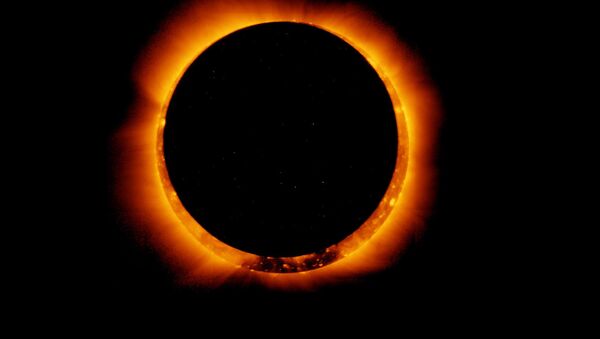Totality from @nashvillezoo @wkrn #eclipse2017 pic.twitter.com/defKP6cCc2
— Nikki Burdine (@NikkiBurdine) August 21, 2017
That was quite a show @capitalweather pic.twitter.com/6iozg3mERP
— Chris Duncan (@CTDPIX) August 21, 2017
Tourists flocked to places like Salem, Oregon, (where the eclipse made landfall) and Charleston, South Carolina, (where it exited into the Atlantic Ocean) to witness the astronomical phenomenon, the most impressive in almost a century.
Eclipse shadow fools sensors at this QT station in Douglas County Ga. Lights came on when it started getting darker. #EclipseOn2. pic.twitter.com/8QcxQ9IWoz
— Tom Regan (@tomreganWSB) August 21, 2017
The @Space_Station as seen during #SolarEclipse17. https://t.co/wRbtti9ebS pic.twitter.com/rJpQuMPnak
— Mark Kelly (@ShuttleCDRKelly) August 21, 2017
The viewings were tainted by reports of faulty eclipse eyewear (the sun is dangerous to stare at, even when it's blocked by the moon) and lost productivity (to the tune of $700 million, according to executive firm Challenger, Gray & Christmas), in addition to horror stories about logistical nightmares in the numerous small towns along the eclipse's path, which temporarily played host to tens of thousands of eager eclipse viewers from across the country.
This doesn't even do it justice! The temp dropped like crazy! Birds were flying everywhere. A sunset all around! Beautiful!!! pic.twitter.com/3Yc7Utctfn
— Fatniss Neverlean (@Sofooo) August 21, 2017
in case you missed it, the solar eclipse #EclipseSolar2017 pic.twitter.com/flrCEwGbuh
— jon (@ohhellojon) August 21, 2017
A solar eclipse occurs when the moon and the sun's orbits sync up, causing the moon to block (or "occult") the sun. For a few minutes, the moon entirely obscures the sun's disk, with only the bubble of superheated plasma (the corona) around the sun being visible.
This WAS SO FREAKING COOL! Total totality!! Loved ever minute of this #eclpse @chswx #charleston pic.twitter.com/vZYdOqSdAU
— ⚾️🌴❤Suz (@suzjdean) August 21, 2017
Found us a stunning place to watch the #eclipse Pomona Natural Bridge. Illinois. Totality is stunning! pic.twitter.com/b5BUvzSyaS
— M.J. Mouton (@MJ_Mouton) August 21, 2017
Partial eclipses (when the moon only blocks a fragment of the sun) and annular solar eclipses (when the moon is in front of the sun, but sunlight is still able to creep around the edges and reach Earth) are common occurrences — but a true total solar eclipse is quite rare.
This is what 99% totality looks like my friends! pic.twitter.com/yCBAIgfddT
— James Torrez (@JamesTorrez_NC9) August 21, 2017
Here's a look at the full #SolarEclipse as seen and photographed by me in Sparta, TN. Wow. pic.twitter.com/pqiNb7okfI
— Brad Maushart (@BraaadWx) August 21, 2017
The last year that a total solar eclipse was visible in the continental United States was 1979, and then only in five states. The 2017 eclipse is the most impressive one to be visible since the 1918 event, the last one to cross the United States from coast to coast.
Ken Miller is in Fredericksburg getting this view of the eclipse through his #Eclipse2017 box. @WTOP pic.twitter.com/aDb0RIlCrf
— Dennis J. Foley (@DJFoleyWTOP) August 21, 2017
And here's the view from DC (thru glasses). 82% coverage is still mighty impressive. #eclipse pic.twitter.com/QTfijOTRW7
— Blayne Alexander (@ReporterBlayne) August 21, 2017
But those who miss the most breathtaking American astronomical event of the last century won't have to wait another 100 years. A solar eclipse of comparable size (crossing over 12 states) will pass from coast to coast in April 2024.
.@POTUS watching the #SolarEclipse2017 pic.twitter.com/1uUAWKKjQn
— Toluse Olorunnipa (@ToluseO) August 21, 2017
Don't look up at the solar eclipse without protective gla—oh, okay… never mind then I guess. pic.twitter.com/MZfBon1Al3
— The Humanist Report (@HumanistReport) August 21, 2017


